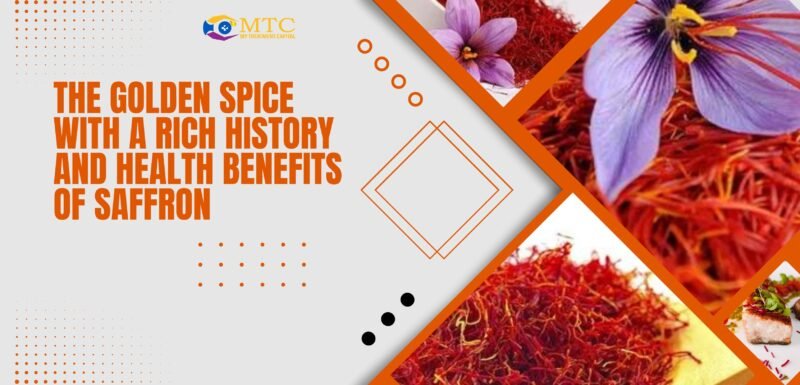Saffron, frequently referred to as the “king of spices,” is a treasured and fragrant spice derived from the flower of Crocus sativus, typically known as the saffron crocus. With its one-of-a-kind deep orange-purple coloration, unique taste, and an array of health benefits, saffron has been a prized ingredient in culinary and medicinal applications for hundreds of years.
Historical Significance
The history of saffron dates back over 3,500 years, making it one of the oldest recognized species within the global. Its origins may be traced to the historic civilizations of Mesopotamia, in which it was now not simplest used as a culinary spice however additionally held cultural and medicinal importance. Saffron discovered its manner into historical Greek and Roman cultures, in which it became used as a perfume, dye, and flavoring agent.
One of the earliest recorded uses of saffron in cooking comes from the famous historical Indian text, the Rigveda, wherein it became hired as a seasoning for diverse dishes. Saffron also holds a special location in Middle Eastern and Mediterranean cuisines, where it is used in a variety of sweet and savory dishes, which include paella in Spain, biryani in India, and risotto in Italy.
Harvesting and Production
Saffron is derived from the pink stigmas and sorts of the saffron crocus flower. The technique of harvesting saffron is labor-intensive and calls for meticulous care. The plant life blooms for only a quick length each yr, normally within the autumn. Harvesters have to cautiously pluck the delicate threads with the aid of hand, ensuring minimum harm to the treasured stigmas.
After harvesting, the saffron threads go through a drying method to keep their flavor, aroma, and color. This drying technique is normally done in a properly-ventilated location, and the saffron is frequently deployed on trays to ensure even drying. The end result is the valuable saffron threads which are utilized in diverse culinary and medicinal packages.
Culinary Uses
Saffron is a flexible spice that imparts an awesome taste, aroma, and color to an extensive variety of dishes. Its specific profile provides a touch of luxury to each sweet and savory creation. In Middle Eastern and Mediterranean cuisines, saffron is a key factor in dishes along with paella, tagines, and biryanis. Its warm and barely bitter taste enhances the overall flavor profile of these dishes, growing a memorable culinary experience.
In Persian delicacies, saffron performs a central function in lots of traditional recipes, such as saffron-infused rice dishes like Zereshk Polo and Tahdig. Saffron is likewise a commonplace component in desserts like saffron ice cream and saffron-infused goodies. The spice’s capability to supplement each sweet and savory dish makes it a sought-after factor in kitchens round the sector.
Medicinal Properties
Beyond its culinary uses, saffron has been valued for its medicinal properties at some point of records. The spice carries quite a few compounds, which include crocin, safranal, and picrocrocin, which make a contribution to its antioxidant, anti-inflammatory, and potential healing effects.
1. Antioxidant Properties: Saffron is wealthy in antioxidants that assist combat oxidative strain inside the frame. These antioxidants play a critical role in neutralizing free radicals, which might be unstable molecules that may contribute to various chronic illnesses.
2. Anti-Inflammatory Effects: Saffron has tested anti-inflammatory houses, which may be useful in coping with inflammatory conditions. Some studies recommend that saffron may additionally help alleviate symptoms in conditions like arthritis and inflammatory bowel illnesses.
3. Mood Enhancement: Saffron has been traditionally used to uplift mood and alleviate symptoms of mild to mild depression. Some research shows that saffron may impact serotonin degrees within the mind, contributing to its mood-improving outcomes.
4. Potential Cancer-Fighting Properties: Preliminary research has indicated that saffron might also have anti-most cancer homes. Compounds observed in saffron have shown promise in inhibiting the growth of cancer cells in laboratory research, although in addition research is wanted to fully apprehend its capability in most cancers prevention and treatment.
The Cost and Rarity of Saffron
The hard work-in depth harvesting process, coupled with the want for a huge number of plants to provide a small quantity of saffron, contributes to the spice’s excessive cost. Saffron is frequently considered one of the maximum high priced spices globally, with costs per pound surpassing those of many precious metals.
The rarity and price of saffron have also brought about its occasional adulteration. In some cases, saffron may be diluted with other materials to boom volume or artificially beautify its color. To ensure the authenticity and best of saffron, clients are suggested to purchase from legitimate assets and search for precise grading standards, consisting of ISO 3632, which establishes quality criteria for saffron threads.
Saffron in Modern Cuisine
In present day culinary landscapes, saffron remains a sought-after spice, cherished for its capacity to raise dishes to new heights. Chefs around the arena test with saffron in progressive ways, incorporating it into cocktails, sauces, and even goodies. The spice’s versatility permits it to bridge the gap between traditional and contemporary cuisines, making it a staple in upscale eating places and home kitchens alike.
Beyond its use in savory and candy dishes, saffron has additionally located its manner into the world of liquids. Saffron-infused teas and coffees have received recognition for his or her particular flavor profiles and capacity fitness advantages. The delicate floral notes and earthy undertones of saffron make a contribution to a distinct man or woman to those liquids, offering a steeply-priced and fragrant enjoy.
Saffron and Culture
Saffron’s deep ties to various cultures and cuisines make it more than just a spice; it is a symbol of lifestyle, luxury, and hospitality. In many cultures, saffron is related to celebrations and unique activities, wherein its inclusion in dishes indicates opulence and abundance.
For instance, within the Indian subcontinent, saffron is often used as a ceremonial present and performs a tremendous position in non secular rituals. In Iran, the largest producer of saffron globally, the spice is deeply ingrained inside the tradition and is a source of national pride.
Sustainability and Responsible Sourcing
As the demand for saffron maintains to upward thrust, worries about the sustainability of its manufacturing have emerged. Responsible sourcing practices, fair labor conditions, and environmental conservation are essential components of ensuring the lengthy-time period viability of saffron cultivation.
Efforts to promote sustainable saffron farming consist of tasks to improve farming practices, support neighborhood groups, and guard the herbal habitats wherein saffron crocus thrives. By prioritizing moral and environmentally aware practices, the saffron enterprise can make contributions to each the proper-being of producers and the maintenance of this precious spice.
Conclusion
Safron, with its wealthy history, one-of-a-kind flavor, and numerous health benefits, remains a coveted spice within the culinary and medicinal worlds. From historic civilizations to trendy kitchens, saffron has stood the test of time, evolving and adapting to new culinary traits at the same time as maintaining its cultural importance. As we keep discovering the diverse uses and abilities of saffron, it’s important to appreciate the craftsmanship and determination involved in its cultivation, ensuring its legacy for generations to return.



